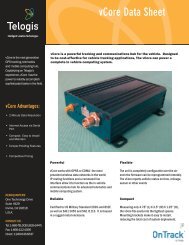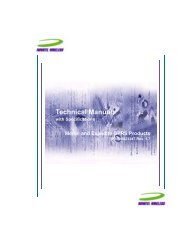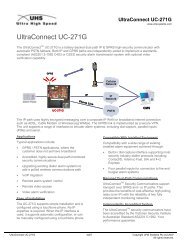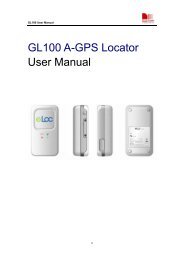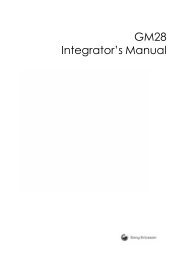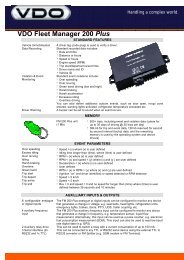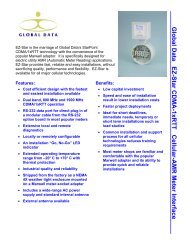Hardware Interface Description - KORE Telematics
Hardware Interface Description - KORE Telematics
Hardware Interface Description - KORE Telematics
Create successful ePaper yourself
Turn your PDF publications into a flip-book with our unique Google optimized e-Paper software.
XT55/56 <strong>Hardware</strong> <strong>Interface</strong> <strong>Description</strong><br />
Confidential / Released<br />
s<br />
3.9 Serial interfaces of the XT55/56 GSM part<br />
The GSM part of the XT55/56 module offers two unbalanced, asynchronous serial interfaces<br />
conforming to ITU-T V.24 protocol DCE signaling. The electrical characteristics do not<br />
comply with ITU-T V.28. The significant levels are 0V (for low data bit or ON condition) and<br />
2.65V (for high data bit or OFF condition). For electrical characteristics please refer to Table<br />
38. Figure 1 shows the serial interfaces of the XT55/56 module.<br />
The GSM engine is designed for use as a DCE. Based on the conventions for DCE-DTE<br />
connections it communicates with the customer application (DTE) using the following signals:<br />
ASC0<br />
• Port TXD @ application sends data to the module’s GSM_TXD0 signal line<br />
• Port RXD @ application receives data from the module’s GSM_RXD0 signal line<br />
ASC1<br />
• Port TXD @ application sends data to module’s GSM_TXD1 signal line<br />
• Port RXD @ application receives data from the module’s GSM_RXD1 signal line<br />
3.9.1 Features supported on the first serial interface of GSM part<br />
(ASC0)<br />
• 8-wire serial interface<br />
• Includes the data lines GSM_TXD0 and GSM_RXD0, the status lines GSM_RTS0 and<br />
GSM_CTS0 and, in addition, the modem control lines GSM_DTR0, GSM_DSR0,<br />
GSM_DCD0 and GSM_RING0.<br />
• It is primarily designed for voice calls, CSD calls, fax calls and GPRS services and for<br />
controlling the GSM engine with AT commands. Full Multiplex capability allows the<br />
interface to be partitioned into three virtual channels, yet with CSD and fax services only<br />
available on the first logical channel. Please note that when the ASC0 interface runs in<br />
Multiplex mode, ASC1 cannot be used. For more detailed characteristics see [12].<br />
• The GSM_DTR0 signal will only be polled once per second from the internal firmware of<br />
XT55/56.<br />
• The GSM_RING0 signal serves to indicate incoming calls and other types of URCs<br />
(Unsolicited Result Code). It can also be used to send pulses to the host application, for<br />
example to wake up the application from power saving state. For further details see<br />
Chapter 3.12.3.<br />
• Autobauding is only selectable on ASC0 and supports the following bit rates: 1200, 2400,<br />
4800, 9600, 19200, 38400, 57600, 115200, 230400 bps.<br />
• Autobauding is not compatible with multiplex mode, see [12].<br />
• ASC0 interface is intended for firmware upgrade of the GSM part<br />
XT55/56_hd_v02.06a Page 55 of 125 17.12.2004



